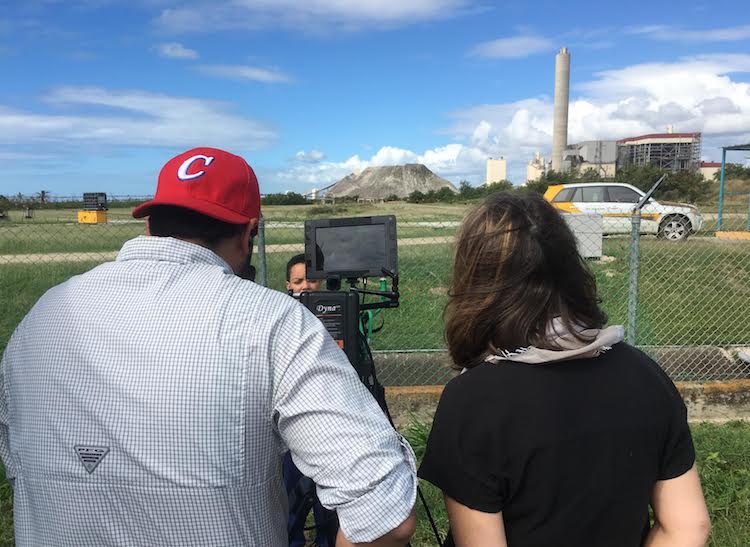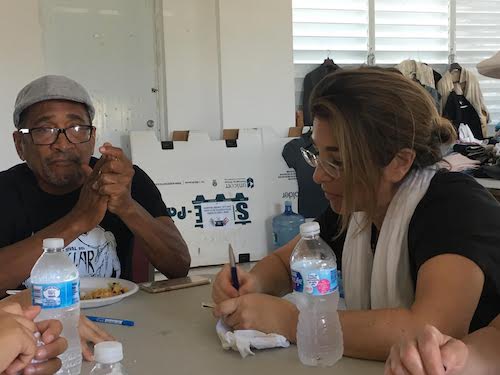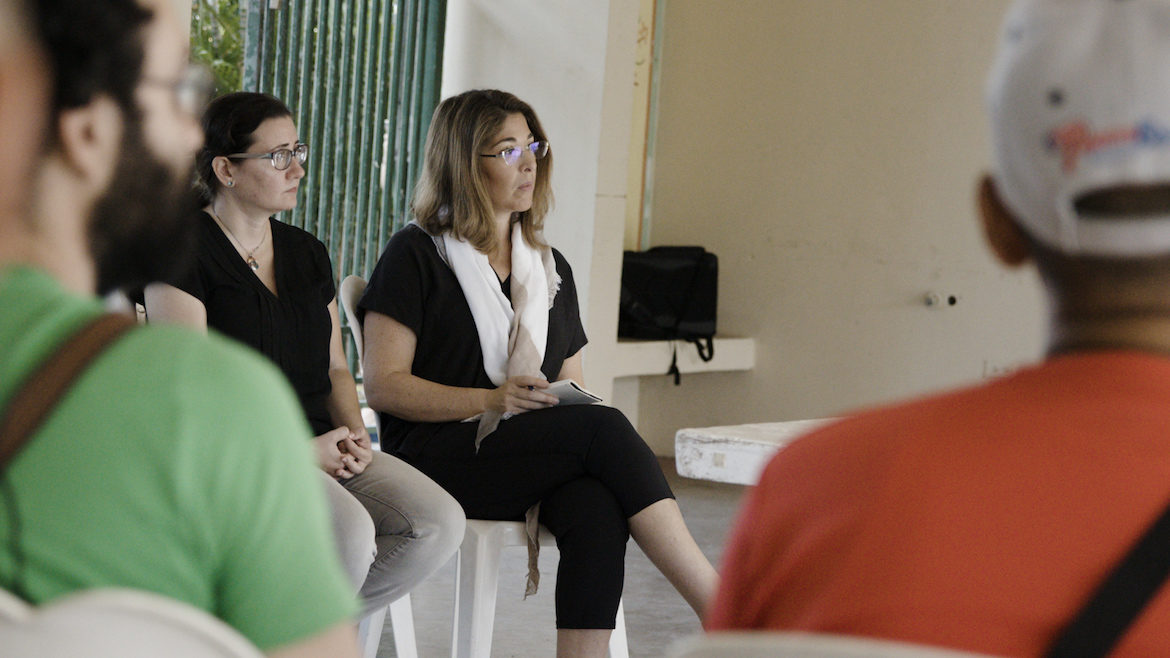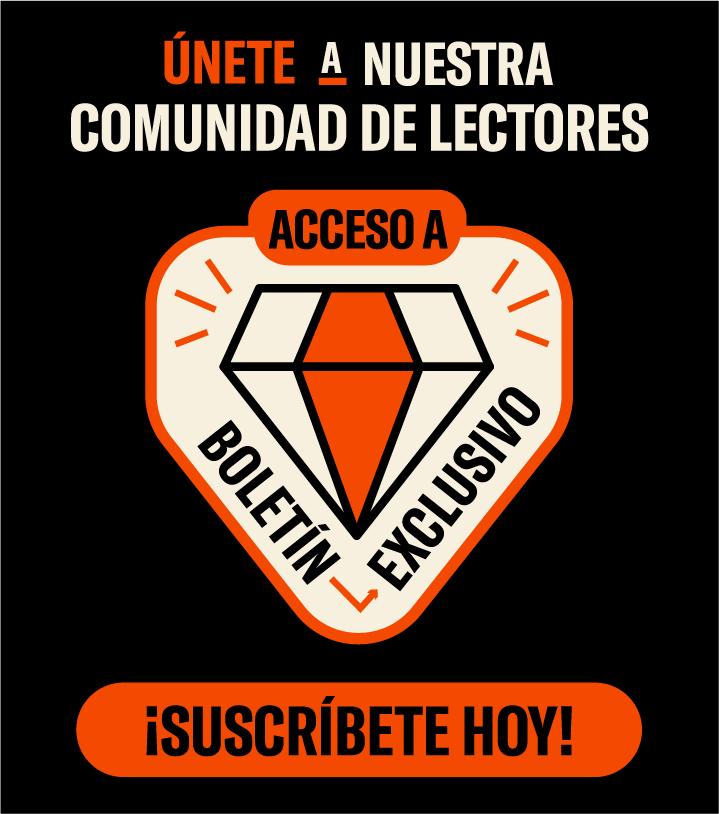Naomi Klein sailed from Jobos Bay in Salinas toward Cayo Caribe, an islet off the southern coast of Puerto Rico. Students, community leaders and fishermen were on board the small boat. It sits next to Boca del Infierno: an area where the Caribbean Sea currents meets the bay; where there are corals, queen conchs, cocolías (small crabs) and lobsters; and where a pipeline, intended to convert the oil-fired Aguirre Thermoelectric Powerplant into natural gas, would pass.
Near the bay is the John F. Kennedy Plaza, an open area with benches and trees that survived the powerful winds of Hurricane María. An archway, still decorated with Christmas lights and garlands, marks the piece of land where there is a gravestone with the name of the deceased president and the dates of his birth and murder, a flower vase with faux roses atop, and a statue of the Virgin Mary.
There, Klein interviewed residents who live by the thermoelectric plant, a steel giant with billowing smokestacks that rise above concrete and wooden houses. The noise made by these turbines never stops, such as airplanes ready for take off, yet they never do. Neighbors say they no longer hear it. Some locals, like Heriberto, worked on its construction in the 1960s. Although they regret doing so since the very first time they heard the explosions of the turbines, it was too late.
On the other side of the plaza is the old Central Aguirre, the island’s last sugar mill, which remained in operation until 1990.
Between the two monuments to modernity that have become obsolescent, sits the Aguirre neighborhood, an enclave surrounded by land and sea, as well as countless promises of progress. It is a microcosm that epitomizes many of Puerto Rico’s contradictions and which served as the setting for the Canadian journalist who sought to understand, in a short period of time, something about this puzzling archipelago in the Caribbean.
Klein went into the houses right next to the thermoelectric plant to conduct some interviews, along with a team of Puerto Rican cameramen hired by The Intercept, where she works. Klein doesn’t use a tape recorder during interviews, even if there is no video camera. She listens, staring closely at her interviewees, and sometimes—only sometimes— takes notes in a small notebook. Nor does she ask many questions; she lets them talk and listens.

Photo by Joel Cintrón Arbasetti | Center for Investigative Journalism
Klein with her team interviews lawyer Ruth Santiago in front of the AES facilities in Guayama, Puerto Rico.
Klein is known for her investigative work, which includes articles, books and documentaries through which she deep-dives into the inequalities and injustices reproduced the world over. As part of that work, she has dedicated herself to revealing the dark side of globalization, sold during the 1990s as the single, definitive development model for countries, imposing the economic system and lifestyles of the United States and Western Europe at a global level.
The first work that earned her an international recognition was “No Logo,” a book published in Canada in 2000 in which she documents and analyzes the influence of brands, as well as the exploitation of cheap labor in the “third world” for the benefit of multinational corporations. In 2004, she made the documentary “The Take,” which tells the story of Argentine workers who, following that country’s economic crisis, occupied factories from which they were fired and transformed them into cooperatives. In that documentary she can be seen in street demonstrations next to the workers and documenting from the very beginning the occupation of one of the factories.
We arrived to Aguirre after a two-hour drive from San Juan, using the Luis A. Ferré expressway and heading south. In the bus were the teachers of PAReS (Spanish for the “Auto-convened Professors in Resistance and Solidarity”), Federico Cintrón, Mariolga Reyes, Juan Carlos Rivera and Bernat Tort, who took care of the wheel. They were part of the group that organized the forum at the University of Puerto Rico in which Klein participated the following day.
On our way, Klein could see some things that have characterized the post-Maria landscape: military trucks traveling on the highway, brigades of U.S. power companies, fallen poles, broken lights, roofs covered with blue tarps, houses turned into rubble and trees growing again.
When Klein saw the first news of the hurricane’s scourge, she was working on an article on climate change, an issue she tackles in her book, “This Changes Everything, Capital vs. the Climate.”
“Climate changes exacerbate pre-existing inequalities. Climate change isn’t about things getting hotter and stormy, is also about things getting meaner and uglier,” says Klein, while stuck in traffic near Caguas. It was raining since dawn and there was some fog.
“We are dealing with this intersecting massive wealth inequality, the reality that climate change is here is upon us, and there are gonna be more and more shocks, more and more extreme events. And this is creating the context for rise and open white supremacy. I don’t think this is coincidence. This is happening because white supremacy is always an intellectual tool to rationalize the practices that otherwise are impossible to rationalize,” she went on to say.
For Klein, the path the world is taking is dark, like a science fiction movie or novel.
“There was a chilin story in the New Yorker, called Survivalist for the super rich, and it was about how these guys in Silicon Valley and Wall Street were increasingly just getting ready for a future that was really, really rocky. Buying land on elevated parts in New Zealand and building bunkers and getting their private security ready… This is not marginal stuff. If you have enough money and you want to live your own world, and Puerto Rico is one of those worlds, like that’s one of the fantasy lands, the paradise that performs. It is this idea of Puerto Rico being turned into a place where the wealthy can retreat from the chaos of the world and build their privatized dream worlds. But that requires fewer Puerto Ricans in Puerto Rico,” she noted.
Klein partly attributes the success of the political right wing to the investments made in foundations and think tanks to promote their ideas. Those who proclaim themselves as progressive or liberal are often financed by economic elites, as well. “[Progressives want things to be a little cleaner, greener, a little less racist and unfair. But they don’t want to change the world fundamentally, they are focused on technocratic solutions,” she said.
“The problem that progressives have in a moment like this is that we haven’t done the groundwork that would be necessary to be able to address a vision in a moment of crisis,” Klein added.
At the Guanina Plaza, in the Puente de Jobos neighborhood in Guayama, Klein met with people who have resisted the operations of a nearby coal plant. After listening to testimonies from residents of the area, including cancer patients and others with health conditions that experts associate to coal ashes, she moved with a group of residents and students from the University of Puerto Rico to the vicinity of the plant owned by AES.
Security personnel on the site began to mobilize once they saw the group near the fence that protects the land occupied by AES. But they couldn’t cover the giant mountain of ash that remains exposed to the wind.
At 11 in the morning, we headed to the El Coquí community in Salinas. This time Ruth “Tata” Santiago, a lawyer and community leader, was in the bus. She explained to Klein that in addition to the coal plant, the Baxter and Pfizer pharmaceuticals are also in Guayama, while developers of transgenic seeds Monsanto and Syngenta are in other southern towns of the island. They are multinationals that create jobs, but occupy agricultural land, exploit resources such as water, export millions of dollars in products to the U.S. and pay a tax of only 4%, Santiago explained.
On our way to El Coquí, we passed a narrow road with various concrete houses abandoned on both sides of the street. Santiago explained that it is a housing development made on floodplains and that its occupants had to abandon after investing their savings in buying these houses. There are still streets without power in this area, some residents have installed cisterns and water filters, while others have sought to repair power lines themselves, Santiago said.
The government’s announcement of the privatization of the Electric Power Authority (Prepa) coincided with Klein’s visit. For her, in an ideal world, there would be an “alternative Prepa,” “democratic, under community control and that produces clean energy.”
“Privatizing Prepa is a terrible idea, but Prepa is also a terrible company, right, with huge problems,” Klein said. In the absence of alternatives, in the middle of a crisis where in there has been no power in many places for more than four months, “people say yes to anything.” This is the kind of pattern that Klein refers to as the “shock doctrine”.

Photo by Joel Cintrón Arbasetti | Center for Investigative Journalism
Klein spoke at the community center of El Coquí with Nelson Santos Torres, coordinator of the IDEBAJO Solidarity Economy Committee and vice president of the community board.
After we arrived to the community center of El Coquí, a group of residents formed a semicircle and presented themselves. There were clothes on a table, diapers, bottles of water, cans of baby formula and other products to cope with the slowness of the government’s recovery efforts after Hurricane María. There was lunch and Klein made other interviews before going to Jobos Bay to take the boat to Cayo Caribe.
At 3:30 p.m., we left Jobos Bay toward Casa Pueblo in Adjuntas. After going through roads covered with thick vegetation and skirting a road that collapsed by the force of the hurricane, we arrived at the house that serves as the community cultural center of Casa Pueblo, a self-management project that focuses on the protection of natural resources. Klein was waiting there for Alexis Massol, an engineer and one of the founders of Casa Pueblo, and his son, Arturo Massol, a biology doctor.
On the walls of the main hall of the house, there are posters and framed newspaper clippings that document the environmental fights that Casa Pueblo has given, such as the opposition to the mining exploitation in the center of the island in 1980 and the southern gas pipeline, abandoned in 2009. In 2014, Casa Pueblo presented the “posterriqueño”, an LED lamppost that could minimize light pollution and reduce in half the million-dollar cost of lighting public roads. This technology was developed in the Mayagüez campus of the University of Puerto Rico and its creators have denounced that it was left in a limbo because of the indifference and bureaucracy of university authorities.
Klein, who has traveled the world documenting how “disaster capitalism” and the shock doctrine are implemented, considers that the people of Puerto Rico are less vulnerable to that practice.
“The reason why Puerto Ricans would be less vulnerable to this tactic is because when you do something over and over again, it becomes less shocking. And Puerto Ricans have been living the shock doctrine for a very long time. So I think that while Puerto Ricans may be horrified by the way they have been treated and angered by the way they have been treated and sad by the way they have been treated, I don’t think there is more shock as it would be if this happened in California. What has been pushed through in the aftermath, the privatization of Prepa which they immediately started to talk about, immediately, and also talking about privatizing more highways and more infrastructure. That was also not a shock because everybody knew that was waiting on the wind because they try to do it without a huracán, they try to just exploit an economic crisis,” Klein said.
In the main hall of Casa Pueblo, Klein made her last interview of the day to the Massols, who promulgate and demonstrate that they are an example of alternatives to government inefficiency and privatization, that, for various reasons, are not taken into account. From there, Klein went back to San Juan, with the night falling over the mountains of Adjuntas and with her backpack full of testimonies that narrate a history of abuses of power and resistance; stories that regardless of how well-known they may be, will need to be told again while they continue to happen.



